1980 census of population. Characteristics of the ... - Census Bureau
1980 census of population. Characteristics of the ... - Census Bureau
1980 census of population. Characteristics of the ... - Census Bureau
Create successful ePaper yourself
Turn your PDF publications into a flip-book with our unique Google optimized e-Paper software.
Appendix B.- Definitions and Explanations <strong>of</strong> Subject <strong>Characteristics</strong><br />
When relationship is not reported for<br />
an individual, it is allocated according to<br />
<strong>the</strong> responses for age and marital status<br />
for that person while maintaining con-<br />
sistency with responses for o<strong>the</strong>r indi-<br />
viduals in <strong>the</strong> household. The allocation<br />
procedure is described in Appendix D,<br />
"Accuracy <strong>of</strong> <strong>the</strong> Data."<br />
Householder—One person in each house-<br />
hold is designated as <strong>the</strong> "householder."<br />
In most cases, this is <strong>the</strong> person, or one<br />
<strong>of</strong> <strong>the</strong> persons, in whose name <strong>the</strong> home<br />
is owned or rented or is associated with<br />
and who is listed in column 1 <strong>of</strong> <strong>the</strong><br />
<strong>census</strong> questionnaire. If <strong>the</strong>re is no such<br />
person in <strong>the</strong> household, any adult house-<br />
hold member could be designated as <strong>the</strong><br />
"householder." Two types <strong>of</strong> house-<br />
holders are distinguished— a family householder<br />
and a nonfamily householder. A<br />
family householder is a householder living<br />
with one or more persons related to him<br />
or her by birth, marriage, or adoption.<br />
The householder and all persons in <strong>the</strong><br />
household related to him or her are<br />
family members. A nonfamily house-<br />
holder is a householder living alone or<br />
with nonrelatives only.<br />
Spouse—A person married to and living<br />
with a householder. This category<br />
includes persons in formal marriages as<br />
well as persons consensually married.<br />
Child—A son, daughter, stepchild, or<br />
adopted child <strong>of</strong> <strong>the</strong> householder, regard-<br />
less <strong>of</strong> <strong>the</strong> child's age or marital status.<br />
The category excludes sons-in-law and<br />
daughters-in-law. "Own children" are<br />
sons and daughters, including step-<br />
children and adopted children <strong>of</strong> <strong>the</strong><br />
householder who are single (never<br />
married) and under 18 years <strong>of</strong> age.<br />
The number <strong>of</strong> children "living with<br />
two parents" includes stepchildren and<br />
adopted children as well as sons and<br />
daughters born to <strong>the</strong> couple.<br />
"Related children" in a family include<br />
own children and all o<strong>the</strong>f persons under<br />
18 years <strong>of</strong> age in <strong>the</strong> household, regard-<br />
less <strong>of</strong> marital status, who are related to<br />
<strong>the</strong> householder by birth, marriage, or<br />
adoption, except <strong>the</strong> spouse <strong>of</strong> <strong>the</strong><br />
householder.<br />
O<strong>the</strong>r Relative—Any person related to <strong>the</strong><br />
householder by birth, marriage, or adop-<br />
tion, who is not shown separately in <strong>the</strong><br />
particular table (e.g., "spouse," "child,"<br />
"bro<strong>the</strong>r or sister," or "parent").<br />
B-2<br />
Nonrelative—Any person in <strong>the</strong> house-<br />
hold not related to <strong>the</strong> householder by<br />
birth, marriage, or adoption. Roomers,<br />
boarders, roommates, paid employees,<br />
wards, and foster children are included<br />
in this category.<br />
Family<br />
A family consists <strong>of</strong> a householder and<br />
one or more o<strong>the</strong>r persons living in <strong>the</strong><br />
same household who are related to <strong>the</strong><br />
householder by birth, marriage, or adop-<br />
tion. All persons in a household who are<br />
related to <strong>the</strong> householder are regarded<br />
as members <strong>of</strong> his or her family. A<br />
"married-couple family" is a family in<br />
which <strong>the</strong> householder and spouse are<br />
enumerated as members <strong>of</strong> <strong>the</strong> same<br />
household. Not all households contain<br />
families, because a household may be<br />
composed <strong>of</strong> a group <strong>of</strong> unrelated persons<br />
or one person living alone. The measure<br />
"persons per family" is obtained by<br />
dividing <strong>the</strong> number <strong>of</strong> persons in families<br />
by <strong>the</strong> total number <strong>of</strong> families (or family<br />
householders).<br />
Group Quarters<br />
All persons not living in households are<br />
classified by <strong>the</strong> <strong>Bureau</strong> <strong>of</strong> <strong>the</strong> (<strong>Census</strong> as<br />
living in group quarters. Two general<br />
categories <strong>of</strong> persons in group quarters<br />
are recognized:<br />
Inmates <strong>of</strong> Institutions— Persons under<br />
care or custody in institutions at <strong>the</strong> time<br />
<strong>of</strong> enumeration are classified as "Patients<br />
or inmates" <strong>of</strong> an institution regardless <strong>of</strong><br />
<strong>the</strong>ir length <strong>of</strong> stay in that place and<br />
regardless <strong>of</strong> <strong>the</strong> number <strong>of</strong> people in that<br />
place. Institutions include homes,<br />
schools, hospitals, or wards for <strong>the</strong><br />
physically or mentally handicapped;<br />
hospitals or wards for mental, tubercular,<br />
or chronic disease patients; homes for<br />
unmarried mo<strong>the</strong>rs; nursing, convales-<br />
cent, and rest homes for <strong>the</strong> aged and<br />
dependent; orphanages; and correctional<br />
institutions.<br />
O<strong>the</strong>r-This category includes all persons<br />
living in group quarters who are not<br />
inmates <strong>of</strong> institutions. Rooming and<br />
boarding houses, convents or monasteries,<br />
and o<strong>the</strong>r living quarters are classified as<br />
"O<strong>the</strong>r" group quarters if <strong>the</strong>re are 9 or<br />
more persons unrelated to <strong>the</strong> person<br />
listed in column 1 <strong>of</strong> <strong>the</strong> <strong>census</strong> question-<br />
naire; or if 10 or more unrelated persons<br />
share <strong>the</strong> unit. Persons residing in certain<br />
o<strong>the</strong>r types <strong>of</strong> living arrangements are<br />
classified as living in "o<strong>the</strong>r" group<br />
quarters regardless <strong>of</strong> <strong>the</strong> number or<br />
relationship <strong>of</strong> people in <strong>the</strong> unit. These<br />
include persons residing in military<br />
barracks, on ships, or in college dormi-<br />
tories; patients in general or maternity<br />
wards <strong>of</strong> hospitals who have no usual<br />
residence elsewhere; staff members in<br />
institutional quarters; and persons<br />
enumerated in missions, flophouses, etc.<br />
Military quarters include barracks or<br />
dormitories on base, transient quarters<br />
on base for temporary residents (both<br />
civilian and military), and military ships.<br />
Comparability With 1970 <strong>Census</strong> Data-<br />
O<strong>the</strong>r than in American Samoa, <strong>the</strong> defi-<br />
nition <strong>of</strong> a housing unit was <strong>the</strong> same in<br />
<strong>1980</strong> as in 1970 except that in <strong>1980</strong><br />
<strong>the</strong>re was no requirement that <strong>the</strong>re be<br />
cooking facilities for <strong>the</strong> exclusive use <strong>of</strong><br />
<strong>the</strong> household. In American Samoa, a<br />
fale (a structure) was considered a<br />
housing unit if it had individual cooking<br />
facilities. The household reference<br />
person in 1970 was <strong>the</strong> "head <strong>of</strong> house-<br />
hold" (<strong>the</strong> husband in married-couple<br />
families); for <strong>1980</strong> it was changed to<br />
"<strong>the</strong> household member (or one <strong>of</strong> <strong>the</strong><br />
members) in whose name <strong>the</strong> house is<br />
owned or rented or is associated with."<br />
In 1970, a unit in which 6 or more<br />
unrelated persons were living toge<strong>the</strong>r<br />
was classified as group quarters; for<br />
<strong>1980</strong> that requirement was raised to<br />
10 or more unrelated persons.<br />
SEX<br />
The data on sex were derived from<br />
answers to question 3. At <strong>the</strong> time<br />
<strong>of</strong> field review, most cases in which<br />
sex was not reported were resolved by<br />
determining <strong>the</strong> appropriate entry from<br />
<strong>the</strong> person's given name and household<br />
relationship. When sex remained blank,<br />
it was allocated according to <strong>the</strong> relation-<br />
ship to <strong>the</strong> householder and <strong>the</strong> age and<br />
marital status <strong>of</strong> <strong>the</strong> person. The allo-<br />
cation procedure is described in<br />
Appendix D, "Accuracy <strong>of</strong> <strong>the</strong> Data."<br />
ETHNICITY<br />
The data on ethnicity were derived from<br />
<strong>the</strong> answers to question 4. The <strong>1980</strong>





